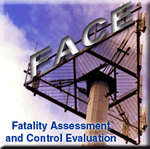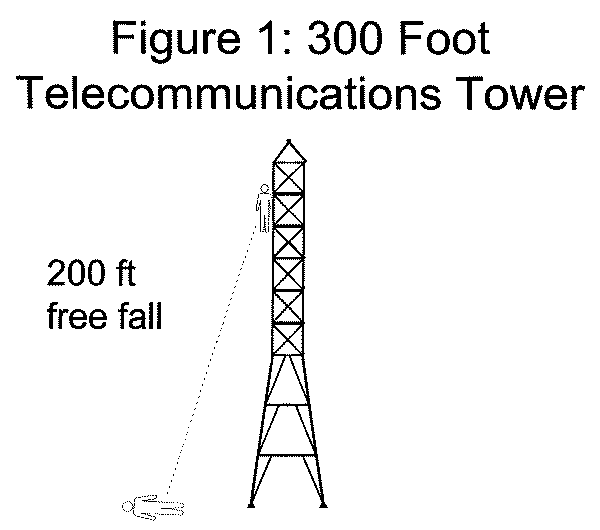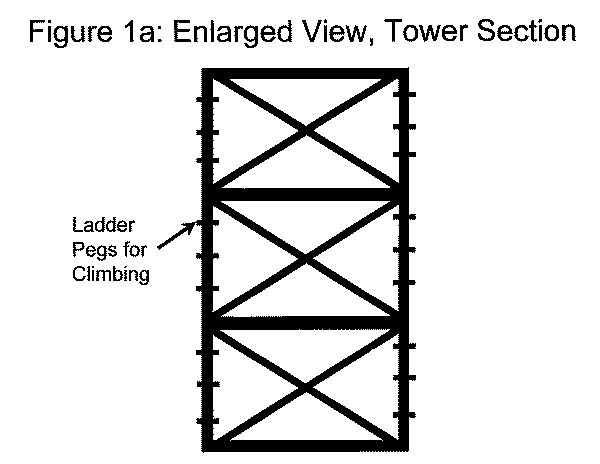NIOSH Fatality Assessment and Control Evaluation (FACE) Program
|
Tower Erector/Inspector Dies after Falling 200 Feet from a Telecommunications Tower to the Ground in North Carolina
|
| NIOSH In-House FACE Report |
FACE 9710
|
SUMMARY (top)
On May 15, 1997, a 38-year-old male tower erector/inspector (the victim) died as a result of injuries sustained in a 200-foot fall from a telecommunications tower. The incident occurred while the victim and a co-worker were connecting antenna-support brackets onto a leg of the tower. The victim apparently disconnected or was attempting to re-connect his fall protection and was climbing down the leg of the tower from 220 feet to 200 feet when he fell to the ground. The victim was pronounced dead at the scene by rescue personnel. 
NIOSH investigators determined that to prevent similar occurrences, employers should:
- enforce existing safety programs, policies and procedures at all times
- thoroughly plan all work and perform a job hazard analysis of the site prior to starting work to ensure employees' knowledge of the use of new tools or new tasks
- provide a system or method of fall protection that protects employees at all times when working at elevations
- ensure that fall protection equipment is appropriate and maintained in good condition.
INTRODUCTION (top)
On May 15, 1997, a 38-year-old male tower erector/inspector (the victim) died as a result of injuries sustained in a 200-foot fall from a telecommunications tower. On May 21, 1997, officials of the North Carolina Occupational Safety and Health Administration (NCOSHA) notified the Division of Safety Research (DSR) of this incident, and requested technical assistance. On June 11, 1997, a DSR safety engineer and safety specialist met with the NCOSHA compliance officer and the company owner, and examined equipment similar to that involved in the incident. Additional information was obtained from the NCOSHA file, co-worker witness statements, and the sheriff's report. The site was photographed during the investigation.
The employer was a construction contractor who specialized in tower erection. The company has been in business since 1994 and employed 27 workers, several of whom were "tower hands" who worked aloft regularly. The company had a safety program and written safety procedures. Employee training for climbing and welding appeared to be gained on the job and through tailgate meetings. Safety topics covered at the meetings included rigging safety, climbing safety, and first aid. Although the victim had worked for this company as a tower erector/inspector for only 1 year, he had previously worked as a tower erector for another company. This was the first fatality experienced by the employer.
INVESTIGATION (top)
The victim was a member of a five-man crew, 2 senior tower erector/inspectors, a junior tower erector/inspector, a welder, and a supervisor, erecting a 300-foot communications tower (Figure 1). The crew had been on site for 3 days, and were using a "jin" pole secured on the interior of the three-faced tower, and a winch truck to lift the tower components into place. A "jin" pole is a pulley-oriented lifting device used to position various equipment into place. Each 20-foot tower section (Figure 1a - enlarged) consisted of 3 legs installed in a triangular configuration. The legs were connected to the preceding 20-foot section using 4 bolts, one in each corner of the overlaying plates. Two cross members were then installed diagonally between the 2 legs on each side to complete the 3 tower faces for that section. The cross members were connected to the legs by a bolt. As each section was completed, the "jin" pole was repositioned higher in the interior of the tower. On the day of the incident, the crew arrived at the site at approximately 8:00 a.m. The victim and a second senior tower erector/inspector (his brother) climbed the tower to the work area. The junior erector/inspector and welder remained on the ground assembling the section faces, hooking up and raising the components into position with the winch truck.
At approximately 10:30 a.m., the tower was complete to the 200-foot level. The workers had installed the legs for the next section and had climbed to the 220-foot level to connect the top of the cross members, which had been hoisted into place, to the tower legs. After the connections were made, the workers began to climb back down to the 200-foot level to connect the cross members to the bottom of the legs. As the men were descending the legs, both the victim's brother and the men on the ground heard a clanging sound. When the brother looked across the tower, he did not see the victim. The workers on the ground looked up and saw someone was falling. A coworker on the ground immediately called 911 and the company owner from a radio in the company truck. The victim was pronounced dead at the scene.
CAUSE OF DEATH (top)
The Medical Examiner listed the cause of death as multiple trauma.
RECOMMENDATIONS/DISCUSSION (top)
Recommendation #1: Employers should continually stress to all employees the importance of following established safety rules and procedures at all times.
Discussion: Standard practice calls for testing the connection of the anchorage point prior to releasing a grip on the structure. The company also had a policy of three-point contact at all times if not tied-off. It appears that the victim did not test his connection prior to relying on it to support his full weight or lost one of his three points of contact with the structure. In accordance with the OSHA Act, P.L. 91-596, Section 5(b)."each employee shall comply with occupational safety and health standards and all rules, regulations, and orders... which are applicable to his own actions and conduct." The employer in this incident managed a comprehensive and detailed safety program on the project that addressed the hazards to which his employees could reasonably expect to be exposed. The fact the incident occurred in spite of these policies clearly shows the need for employers to continually remind all employees of the importance of following established safety rules and procedures at all times.
Recommendation #2: Employers should thoroughly plan all work and perform a job hazard analysis of the site prior to starting work, anticipating that employees might have a lack of knowledge about safety at the site, instead of waiting for employees to raise questions.
Discussion: The company states that there is weekly training on climbing safety involving proper personal protective equipment (PPE) (inspection and use) as well as, a hazard assessment of each job site. The site supervisor is in charge of weekly training, certification (first aid, life safety, etc.) of employees on site, and hazard assessment of each job. It is recommended that once on site, a job hazard analysis be done by the employer and workers together. Worker safety issues should be discussed and incorporated into all projects during the planning and throughout the entire project. The planning for and incorporation of safety measures, prior to any work being performed at job sites, will help to identify potential worker hazards so that preventive measures can be implemented at the site.
Recommendation #3: Employers should provide a system or method of fall protection that protects employees at all times when working at elevations. At a minimum, three-point contact (one foot and two hands or vice versa) should be maintained.
Discussion: In this case, the employee fell from the tower after he apparently disconnected or was reconnecting his fall protection in order to move down the structure. Moving without fall protection is standard procedure with this type of work and requires a minimum of three-point contact at all times; traditional fall protection for this job is more effective when the employee is stationary and tied onto the structure. It is recommended that other methods of fall protection be used that protect employees while they are moving as well as when stationary. For example, a lifeline system or cable safety climb device provides a tie-off point for the employee to hook onto, and provides fall protection coverage at all times. For a tower leg or similar vertical structure, a fall arrester (e.g., rope grab) should be worn by the employee and attached to the lifeline, enabling the worker to move freely without interference until a free fall is detected.
Recommendation #4: Employers should ensure that fall protection equipment is appropriate and maintained in good condition. Employers should periodically inspect fall protection equipment to ensure that all components are in operational order.
Discussion: Connecting clasps on lanyards are equipped with a locking mechanism. Such a mechanism prevents the clasp from opening unintentionally. To prevent unintentional opening, it is recommended that all lanyard clasps be equipped with locking mechanisms. It was observed that some of the other lanyards at the site appeared old and worn. Lanyards and other nylon equipment should also be periodically replaced to prevent equipment failures, as nylon will deteriorate with age and exposure to ultraviolet light from sunlight and welding arcs. It is also recommended that employers and employees periodically inspect all fall protection equipment to ensure that it is in operational order.
REFERENCES (top)
1. Public Law 91-596, December 29,1970, the "Occupational Safety and Health Act of 1970", Section 5(b).
2. Code of Federal Regulations 29 CFR 1926, 1996 edition. U.S. Government Printing Office, Office of the Federal Register, Washington DC.


|